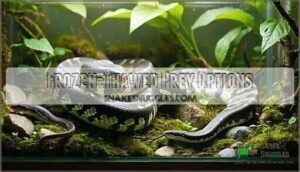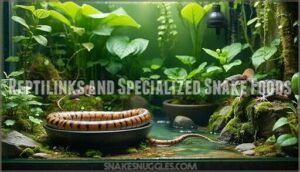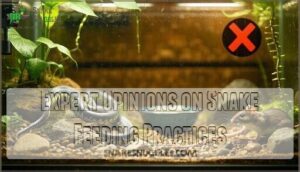This site is supported by our readers. We may earn a commission, at no cost to you, if you purchase through links.

They can pass on over 25 nasty diseases, dangerous parasites, and even toxic chemicals.
Imagine your snake picking up a roundworm or catching something a mouse dragged in—nobody wants that drama.
Wild prey is a roll of the dice with nutrition too, and those tiny teeth can leave your snake with scratches or worse.
You’re better off choosing commercially bred mice. It’s safer, cleaner, and your snake will thank you.
Next up: smart feeding swaps for healthier, happier snakes.
Table Of Contents
- Key Takeaways
- Wild Mice: a Dangerous Diet for Pet Snakes
- Potential Injuries From Feeding Wild Mice
- Impact on Snake’s Stress Levels and Behavior
- Safe Alternatives to Wild Mice for Snakes
- Transitioning Your Snake to Safe Food Sources
- Legal and Ethical Considerations of Wild Mice Feeding
- Health Risks to Humans From Handling Wild Mice
- Importance of Proper Snake Nutrition
- Expert Opinions on Snake Feeding Practices
- Frequently Asked Questions (FAQs)
- Can pet snakes eat wild mice?
- Can you eat frozen mice?
- Do PetSmart snakes eat mice?
- Can snakes eat frozen mice?
- Can my pet snake eat wild mice?
- Is it okay to feed my snake 2 mice?
- What pet snake doesn’t eat mice?
- What can snakes not eat?
- Are wild mice nutritionally adequate for snakes?
- How do wild mice affect snake digestion?
- Conclusion
Key Takeaways
- Don’t feed your snake wild mice—they carry diseases, parasites, chemicals, and unpredictable nutrition.
- Commercially bred or frozen-thawed mice are much safer and give your snake balanced nutrition.
- Wild mice can injure your snake with bites or scratches, leading to infection and stress.
- Sticking to trusted feeder mice avoids legal and ethical problems—and keeps both you and your pet safe.
Wild Mice: a Dangerous Diet for Pet Snakes
You’re putting your snake at serious risk if you’re considering wild mice as food.
Feeding wild mice is a gamble with your snake’s health you should never take
Wild rodents carry dangerous diseases, parasites, and toxins that can harm or even kill your pet snake.
Disease Transmission Risks
Wild mice present four critical disease transmission risks that threaten your snake’s health.
These feisty rodents carry dangerous pathogens you can’t see coming.
Here’s what lurks beneath the surface:
- Bacterial Exposure – Salmonella and Listeria contaminate up to 40% of wild populations
- Viral Infections – LCMV and hantavirus spread through infected tissue consumption
- Zoonotic Risks – Over 25 diseases jump from wild mice to snakes and humans
- Toxic Contamination – Environmental pollutants accumulate in wild rodent systems
Don’t roll the dice with disease transmission.
Commercial feeders eliminate these wild mice safety concerns completely.
Parasitic Infections
Most parasites found in wild mice don’t discriminate when choosing their next host.
Research shows 47.3% of captive snakes harbor endoparasites, often from wild prey.
Roundworm Risks and Tapeworm Dangers multiply when you feed wild rodents. Mite Infestations can introduce blood parasites too.
Commercial prey eliminates these parasites naturally, keeping your snake healthier without zoonotic diseases complications.
Understanding reptile parasite issues is vital for snake owners to prevent such health risks.
Toxicity Concerns
Beyond parasites, wild mice carry serious toxicity concerns that could poison your snake.
These rodents often consume pesticides, rodenticides, and environmental toxins that accumulate in their tissues.
When your snake eats contaminated wild mice, it’s basically consuming concentrated chemicals that can damage organs and disrupt normal bodily functions.
Feeding wild mice turns your snake’s dinner into a dose of hidden toxins that silently attack their health
Heavy metals from pollution and bacterial contamination add another layer of danger.
Chemical exposure through wild prey creates unpredictable health risks, including LCMV and other zoonotic diseases.
Unlike commercially bred mice with controlled diets, wild rodents roam freely through contaminated environments, absorbing whatever toxins they encounter.
You’re basically serving your snake a meal laced with unknown chemicals.
This practice can lead to severe consequences, making it crucial to consider the source of the food for your snake, opting for safer, commercially bred options to avoid unpredictable health risks.
Nutritional Imbalances
Feeding wild mice creates significant nutritional imbalance risks that threaten your pet snake nutrition. These critters consume unpredictable diets, making their dietary requirements impossible to assess.
You can’t control what they’ve eaten, leading to serious dietary risks.
Consider these malnutrition effects:
- Nutrient deficiency causing stunted growth and weakened immunity
- Feeding disorders from inconsistent protein and fat content
- Nutrient toxicity from accumulated environmental contaminants
- Metabolic disruption affecting long-term health and behavior
Commercial prey eliminates these snake diet risks, providing consistent nutrition your pet needs.
Potential Injuries From Feeding Wild Mice
Someone might think that wild mice offer a natural meal, but they’re actually dangerous weapons waiting to strike. These rodents fight back with razor-sharp teeth and claws, creating serious bite wounds and feeding injuries for your snake.
Mouse bites can penetrate your snake’s scales, leading to deep infections. Wild rodents scratch desperately during snake attacks, potentially damaging eyes or creating entry points for bacteria. The risk of injury multiplies when feeding wild mice because they’re unpredictable fighters.
Even small scratches become gateways for potential health issues. These snake feeding risks aren’t worth taking when safe alternatives exist. Frozen-thawed prey eliminates the battle entirely, giving your snake nutrition without the war wounds.
Impact on Snake’s Stress Levels and Behavior
Wild mice can trigger severe stress responses in your pet snake, leading to unpredictable behavioral changes that affect their overall well-being.
You’ll notice increased anxiety, feeding refusal, and aggressive tendencies that can persist long after the initial exposure to wild prey, which can lead to severe stress and impact their well-being.
Anxiety and Aggression
Wild mice create stress factors that transform your snake’s peaceful demeanor into aggressive behavior.
Snake anxiety manifests through specific warning signs that shouldn’t be ignored.
Captive stress from wild prey triggers measurable physiological changes:
- Heart rates spike 20-40% above normal during feeding encounters
- Corticosterone levels increase up to 50%, compromising immune function
- Defensive striking toward handlers increases by 30-45%
These stress levels persist days after feeding, creating chronic anxiety that affects your snake’s overall temperament and health.
Feeding Refusal
Stressed snakes often develop feeding refusal, turning away from meals entirely.
This food aversion disrupts normal eating habits and creates serious feeding issues.
Your snake’s appetite may vanish for weeks, leading to dangerous weight loss.
Refusal causes include environmental changes, illness, or improper prey temperature.
Monitor your pet’s snake eating habits closely – consistent refusal signals deeper problems requiring immediate veterinary attention.
Long-term Health Effects
Your snake’s body becomes a battleground when wild mice introduce toxicity risks and parasite infections. These silent threats compound over months, creating devastating longterm health effects that’ll break your heart.
Nutrient deficiencies from inconsistent wild prey weaken your pet’s foundation, while disease transmission overwhelms their system. Immune suppression leaves them defenseless against infections that commercial prey would never carry.
Recognizing snake stress symptoms is essential to prevent these issues.
Here’s what chronic wild mouse feeding destroys:
- Liver function deteriorates from accumulated toxins
- Growth stunts permanently due to nutritional imbalance
- Reproductive health fails from organ damage
- Behavioral changes signal neurological harm
- Lifespan shortens dramatically from systemic stress
Smart snake diet tips emphasize consistent nutritional balance through safe alternatives.
Safe Alternatives to Wild Mice for Snakes
Fortunately, you’ve got several excellent alternatives that’ll keep your snake healthy and satisfied.
Commercially bred feeder rodents, frozen-thawed options, and specialized snake foods provide all the nutrition your pet needs without the serious health risks.
Commercially Bred Feeder Rodents
Commercially bred mice represent the gold standard for snake feeding. These rodents undergo rigorous breeding practices in controlled facilities, ensuring nutritional consistency that wild prey simply can’t match.
Disease prevention protocols screen feeders for pathogens like Salmonella, protecting your snake health. Ethical sourcing means these mice for snakes live in humane conditions before processing.
Sure, cost analysis shows commercial feeders cost more upfront. But you’re buying peace of mind and your pet’s wellbeing.
These standardized snake diet options eliminate guesswork about nutrition and contamination. Professional breeders follow strict health protocols, giving you reliable feeding solutions that support ideal growth and longevity in your serpent companion.
To save on costs, some owners consider breeding rats for food.
Frozen-Thawed Prey Options
Frozen-thawed prey represents your ticket to stress-free snake feeding. Unlike commercial breeders, these pre-killed options pack consistent nutritional value without the guesswork.
Here’s what makes frozen prey your best bet:
- Storage safety – Keep months of meals in your freezer without spoilage
- Proper prey size selection guarantees safe swallowing for your snake
- Scenting techniques help picky eaters accept frozen-thawed prey
Thawing methods matter – refrigerate overnight, never microwave. This pet snake food eliminates live feeding risks while maintaining nutrition. Your snake gets mice as food without the danger.
Many owners rely on purchasing frozen snake food for convenient feeding solutions.
Reptilinks and Specialized Snake Foods
You deserve better options than risky wild prey for your pet snake.
Reptilinks revolutionize snake feeding by offering convenient, sausage-like alternatives packed with balanced nutrition.
These specialized feed alternatives contain carefully blended meat, organs, and essential supplements that support ideal reptile nutrition.
While Reptilinks cost more than traditional frozen-thawed prey or commercially bred mice, they deliver unmatched convenience and pet food safety.
You’ll find these innovative snake feeding options available online and at select retailers.
The Reptilink benefits include consistent nutritional profiles and easy storage, making them excellent additions to diverse snake diets without the hassles of whole prey handling.
Reptilinks are a great example of a reptile food source that provides a balanced diet for snakes.
Transitioning Your Snake to Safe Food Sources
If you’ve been feeding your snake wild mice, making the switch to safer alternatives doesn’t have to be stressful for either of you.
Most snakes adapt quickly to frozen-thawed prey with the right approach, and you’ll both be healthier for it.
Scenting Methods
One trick up your sleeve is using Prey Scenting to make new food more tempting.
Rub the safe prey with bedding, feathers, or droppings from a wild mouse diet—this taps into your snake’s natural Feeding Cues.
By mimicking the familiar Food Aroma, you’ll boost acceptance.
Scent Marking with attractant methods helps even picky snakes.
Keep an eye out to see which scents do the trick.
These snake care tips will keep your snake’s nutrition balanced, following any good snake feeding guide.
Understanding snake food scent preferences is vital for a successful shift.
Overcoming Feeding Resistance
If scenting tricks haven’t cracked your snake’s stubborn streak, don’t give up yet. When switching from a wild mouse diet, a few clever Feeding Techniques can help.
Sometimes, snakes just need a bit more Snake Training and clever Food Shift to see things your way. Appetite Stimulation is all about subtle moves and patience, turning resistance breaking into an art.
- Wiggle prey with tongs to mimic natural movement
- Offer food at dusk or night for better results
- Try various prey like earthworms if needed
- Always use a calm, quiet spot
- Ask a vet for expert snake care tips
Legal and Ethical Considerations of Wild Mice Feeding
Before offering wild mice to your snake, you’ll need to reflect on local wildlife laws and ethical issues around animal welfare.
Following the rules protects both your pet and native species, and helps you stay a responsible snake owner.
Wildlife Protection Laws
While swapping out wild mice for safer food options, don’t forget that wildlife protection laws are there for a reason.
Trapping wild mice isn’t just risky for your pet snake—it can land you in legal hot water.
Conservation efforts and habitat preservation depend on these wildlife regulations. Taking animals out of their environment disturbs local ecosystems and may even impact endangered species.
Stick to commercial feeders, as it keeps your pet snake safe and supports responsible pet ownership and sound environmental policies.
Animal Welfare Concerns
Feeding wild mice to your pet snake raises important animal welfare and ethics questions.
Wild mice aren’t just food—they’re part of the ecosystem, and capturing them can disrupt local balance.
There’s real concern for both Snake Stress and Pet Safety, not to mention Animal Rights and Welfare Ethics.
Humane Treatment is key—live prey can injure your snake and suffer stress themselves.
Instead, consider safer options.
- Reduces risk of zoonotic diseases
- Supports humane treatment
- Avoids injury to your snake
- Prevents ecosystem disruption
- Aligns with animal welfare standards and wildlife protection laws
Responsible Pet Ownership
It’s not just about dropping a mouse in a tank and calling it a day.
Responsible pet ownership means making smart choices for pet care and safety, not just for your snake, but for your whole household.
If you’re feeding wild mice, you risk bringing snake health risks and even owner liability into play.
Instead, focus on a solid Snake Habitat and follow these key steps:
- Secure your snake’s enclosure to avoid unplanned adventures.
- Follow veterinary advice for diet.
- Prioritize animal welfare—both for your snake and local wildlife.
Understanding the risks of wild prey is vital for maintaining proper pre killed prey practices to safeguard snake health and safety.
Health Risks to Humans From Handling Wild Mice
When you handle wild mice, you put yourself at risk for serious diseases and harmful germs they may carry.
Even a quick touch can lead to problems if you’re not careful with cleaning and using protective gear.
Zoonotic Diseases
When you handle wild mice, you’re opening the door to serious trouble. They’re tiny, but they pack a punch—carrying zoonotic diseases like Salmonella, Hantavirus, Lymphocytic choriomeningitis, and Rat-bite fever.
Disease transmission doesn’t stop with a mouse bite; you can pick up these pathogens just by touching or breathing near contaminated bedding.
Parasite control is hard here—mites and bacteria ride along for the journey, making bacterial exposure and viral infections a danger you don’t want, and these risky snacks are a real wild card.
Proper Sanitation Practices
Keeping things spotless goes a long way in the context of Enclosure Cleaning and Feeding Hygiene for your pet snake’s health.
Here’s how you can step up your Sanitation Methods and boost disease prevention after dealing with wild mice:
- Check for rodent droppings or bite marks around your snake’s space.
- Disinfect all surfaces using a strong household cleaning solution.
- Don’t sweep or vacuum rodent mess—those germs become airborne easily.
- Stick with snap traps to avoid too much contact.
Good sanitation protects pet snake safety and keeps disease away.
Personal Protective Equipment
Ever wonder how to dodge hidden health risks from wild mice?
Glove Selection matters—choose sturdy gloves, wear a mask, safety glasses, and protective clothing. That’s Safe Handling 101.
Disinfection Methods and Proper Disposal of waste are non-negotiable for pet snake safety.
Training Protocols help lower your exposure to diseases and parasites. Always put protective equipment between you and trouble, following complete concepts for safety.
Importance of Proper Snake Nutrition
You want your snake to thrive, not just survive, so it needs a balanced diet with the right nutrients.
Feeding proper foods keeps your pet healthy, active, and less likely to develop problems later.
Essential Nutrients for Snakes
Snake nutrition is all about balance. You’ll want to cover the basics: reliable protein sources, vitamin needs, and mineral balance for strong bones.
Don’t overlook hydration importance and a little dietary variety—this keeps your pet healthy. A good balanced diet guarantees your snake gets protein, fat, and critical nutrients, all essential for meeting basic dietary requirements and thriving long-term.
Securing the correct calcium-phosphorus ratio is also essential for bone health.
Species-Specific Dietary Requirements
Just as you learned about essential nutrients, let’s talk about matching your snake’s food to its species.
Every snake species has unique dietary requirements.
You’ll need to take into account Snake Age, Prey Size, Nutritional Needs, and Dietary Variety.
Feeding Frequency matters, too.
Feeding wild mice can pose health risks and diseases if they don’t align with the right nutritional profile.
Ignoring these dietary requirements can lead to digestive problems and slow down your snake’s happy slither due to poor nutritional alignment.
Feeding Schedules and Portion Control
Feeding pet snakes isn’t just about tossing in a mouse and hoping for the best.
After figuring out species-specific dietary needs, you’ll want to fine-tune feeding schedules and portion control.
Remember:
- Adjust feeding frequency as your snake ages—hatchlings eat more often.
- Match prey size to your snake’s width, not your own ambition.
- Avoid overfeeding; it’s common and increases health risks, especially with wild mice.
Expert Opinions on Snake Feeding Practices
If you ask snake experts about feeding wild mice, you’ll hear clear advice—stick to safe, healthy prey.
Veterinarians, herpetologists, and breeders all warn that wild-caught food can put your snake at serious risk.
Veterinary Recommendations
Anyone who loves their snake wants to dodge risks like diseases, parasites, and toxins.
Veterinary recommendations are clear: stick with pre-killed or commercially bred rodents for safe, balanced nutrition.
This reduces health risks, from parasite prevention to lowering toxin exposure and nutritional deficiencies.
A balanced diet is essential for proper bodily functions and growth, so pet owners should consider nutritional needs.
Regular health monitoring, guided by Dietary Guidance from your vet, helps keep your snake thriving.
Following these tips keeps you ahead of trouble and lets your pet shine.
Herpetologist Insights
Veterinary voices set the stage, but herpetologists really get into the weeds of wild mice, spotlighting how Disease Prevention starts at the food dish.
Here’s their shortlist:
- Watch for parasites and strange bugs.
- Avoid diseases hidden in wild mice.
- Prioritize Nutritional Science—stick with consistent nutrients.
- Safe Handling and proper enclosures prevent many headaches.
Ethical Considerations always guide Expert Recommendations.
Best Practices From Experienced Breeders
Keeping your pet snake healthy starts with breeding ethics and good quarantine protocols—never rush to introduce new feeder mice without a waiting period.
Strong record keeping lets you track individual feeding habits and spot health risks early.
Opt for pre-killed prey from trusted sources to avoid surprises, and watch closely for changes in behavior; this practice helps fine-tune enrichment strategies and guarantees safe alternatives to wild mice.
With attention to genetic diversity and practical snake care advice, you’re set for responsible snake keeping.
Frequently Asked Questions (FAQs)
Can pet snakes eat wild mice?
Think wild mice are a jackpot for your snake?
Not quite—you’re gambling with germs, parasites, and hidden toxins.
Safer bet: stick to store-bought feeder mice for balanced nutrition and peace of mind for both you and your pet.
Can you eat frozen mice?
You really shouldn’t eat frozen mice yourself—they’re meant for pets, not people.
Even if curiosity calls, these rodents can carry bacteria or parasites.
There’s a reason grocery stores don’t stock frozen mice in the food aisle, which highlights the importance of not consuming them, emphasizing they are not for human consumption, and can carry parasites.
Do PetSmart snakes eat mice?
Don’t worry, you’re not feeding wild-caught critters—PetSmart snakes eat mice, but they stick to commercially bred frozen or pre-killed ones.
That way, you dodge nasty germs, parasites, and unpredictable surprises in your snake’s supper.
Can snakes eat frozen mice?
Yes, snakes can eat frozen mice if you thaw them properly.
It’s safer than live prey—no bites, less disease.
Just make sure the mouse is warm but not cooked, and your snake will thank you.
Can my pet snake eat wild mice?
Catching dinner in the wild seems natural—but wild mice are a mixed bag for your pet snake.
They carry diseases, parasites, and toxins that can harm your snake.
Stick to commercially bred prey for safety and peace of mind.
Is it okay to feed my snake 2 mice?
Feeding your snake two mice is fine as long as the mice aren’t bigger than the widest part of your snake’s body.
Make sure the total meal isn’t too large—overfeeding can bring trouble down the line.
What pet snake doesn’t eat mice?
About 25% of pet snakes prefer diets without mice—garter snakes, water snakes, and egg-eating snakes thrive on fish, amphibians, or eggs instead.
If the idea of feeding mice gives you the creeps, you’ve got options!
What can snakes not eat?
You can’t feed snakes anything with fur balls, dairy, raw pork, or highly spiced meats.
Avoid wild-caught prey, processed foods, and anything with bones too large.
Stick to pre-killed rodents, birds, or reptile-approved feeder options.
Are wild mice nutritionally adequate for snakes?
You might think wild mice are a natural choice, but their nutrition’s all over the map—sometimes too lean, sometimes missing key minerals.
You’re rolling the dice and risking deficiencies; it’s safer to stick with captive-bred rodents, as this approach avoids the potential for deficiencies.
How do wild mice affect snake digestion?
Wild mice can throw a wrench in your snake’s digestion.
They often bring bacteria, parasites, or toxins along for the ride, overwhelming your snake’s gut and creating a breeding ground for health issues you’d rather avoid.
Conclusion
Feeding your snake wild mice is like rolling the dice with its health.
If you’ve asked, “can pet snakes eat wild mice 2,” the answer points to real dangers—disease, parasites, and unpredictable nutrition.
Commercial feeder mice are your safest bet, keeping meal times routine and stress-free.
You’ll avoid hidden risks and keep your snake on track for a long, healthy life.
Stick to what’s tried-and-true, and your pet will thrive under your careful care.
- https://domestigoth.wordpress.com/2014/03/29/feeding-your-reptiles-frozenthawed-rats-and-mice/
- https://www.mass.gov/guides/wildlife-as-pets
- https://www.cdc.gov/lymphocytic-choriomeningitis/about/index.html
- https://pmc.ncbi.nlm.nih.gov/articles/PMC3118381/
- https://www.parahostdis.org/m/journal/view.php?number=2042















